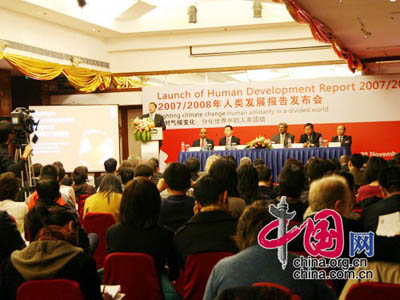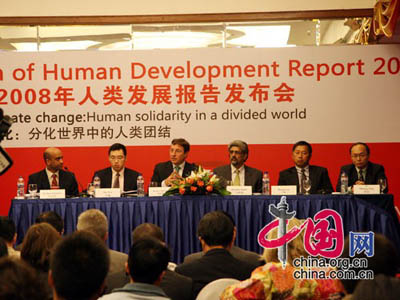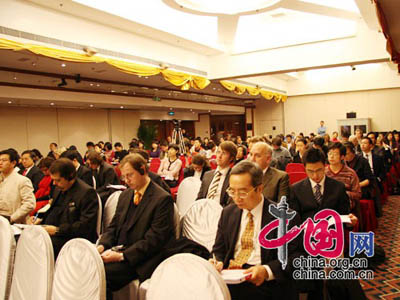International technology transfer is crucial to help reduce carbon emissions in developing countries which themselves are increasingly vulnerable to global climate change. If swift actions are not taken to help the poor to adapt to the adverse impact of climate change, human development progress made in developing countries could stall and even reverse by mid-century, according to the 2007/2008 Human Development Report, released today in Beijing.
The 2007/2008 Human Development Report is released in Beijing on November 28, 2007.
"Climate change is now a common concern for all humanity as a whole to be dealt with through concerted global action. Developing countries such as China, which are rapidly growing in emissions, should play a lead role to find common solutions and take a critical position in the effort to save our planet," said Khalid Malik, United Nations Resident Coordinator and UNDP Resident Representative in China.
Entitled Fighting climate change: Human solidarity in a divided world, the report argues that although China is to become the world's largest source of CO2 emissions over the next decade, a person in the US still emits on average five times more carbon than a person in China.
The report argues that compared to developed countries, which take up 13 percent of world's population and produce over half of CO2 emissions, China has a small per capita carbon footprint by international standards. By 2015, per capita emissions from China are projected at 5.2 tonnes, which is about one-fourth of the 19.3 tonnes in US and a third of the average in developed countries.
"If every person in the developing world had the same carbon footprint as the average person in Canada or the US, we would need nine planets to absorb all of the pollution. We however have only one planet," said Malik.
Sharing responsibilities: turning the tide on climate change
The report argues that the world's richest countries have a historic responsibility to take the lead in balancing the carbon budget by cutting emissions by at least 80 percent by 2050; meanwhile, these countries should also adopt a new mechanism to transfer clean energy technology to developing countries. Supported by such measures, developing countries such as China should also play their part by introducing new clean energy technology to improve energy efficiency and use of renewable energy.
The report stresses that international technology transfer cooperation and capacity building are crucial to help developing countries reduce emissions. This can align with existing energy plans in China that focus on introducing expanded programs for renewable energy and accelerated introduction of clean coal technologies.
The report says that under China's 11th Five-year Plan, the Chinese government has set a wide range of goals to change the current emission situation, for example, establishing clean coal technology initiatives to enhance energy efficiency and set the scene for an early transition to carbon capture and storage; retiring inefficient power plants and industrial enterprises; as well as promoting renewable energy. Under a 2005 renewable energy law, by 2020, China will be producing 17 percent of primary energy from renewable sources – more than twice the level today.
'Tomorrow is today': Investing more in adaptation
The report warns that rapid economic growth has gone hand in hand with a steep decline in poverty, yet China is highly vulnerable to climate change. If not acting quickly, the climate change affected areas in China could experience a reversal in human development by mid-century.
"The poor, who have the lightest carbon footprint and bear no responsibility for the ecological debt we are running up, are the most vulnerable and will be affected the most by global warming," said Malik.
Khalid Malik, United Nations Resident Coordinator and UNDP Resident Representative in China
By 2020, average temperatures in China are projected to be between 1.1 and 2 degrees Centigrade above 1961-1990 level, says the report. If current emissions patterns continue, two-thirds of China's glaciers, including Tianshan, are likely to disappear by 2060 and the remaining ones will be gone by the end of the century. In South and East Asia, changes in rainfall, temperatures and the availability of water would cause great losses in productivity for food staples, thereby thwarting efforts to cut rural poverty. As a result, half of China's 128 million rural poor and 40 percent of the country's agricultural land area which accounts for one-third of GDP may be affected, according to the report.
"Failure to act on climate change will have grave consequence for human development in poor areas in the world, and it will undermine efforts to tackle poverty," Malik added.
Moreover, extreme weather events have become more common during the past few years, such as droughts in north-eastern China, flooding in the middle and lower reaches of the Yangtze River and coastal flooding in major urban centers such as Shanghai. Approximately 3 million people were displaced during the 2007 monsoon period in East Asia, with large tracts of the region registering the heaviest rainfall since records began.
The world's major challenge, mentioned in the report, is to change the emissions trajectory in our global economy without compromising human development. The report stresses that in climate change adaptation, as in other areas, prevention is better than cure. Every US$1 invested in pre-disaster risk management in developing countries can prevent losses of US$7. National research confirms this broad cost-benefit story. In China, the US$3 billion spent on flood defenses in the four decades up to 2000 is estimated to have averted losses of US$12 billion.
UN Response – forging an inclusive partnership
The Chinese government published its first-ever National Climate Change Program in June 2007 outlining the key directions China will take to achieve its own national targets on climate change mitigation and adaptation, and to align with global processes. UNDP and the United Nations family in China are working with key government agencies like National Development and Reform Commission (NDRC) to implement China's new strategy and to integrate key findings from the report on links between climate change and human development.
Specifically, the United Nations in China will soon launch a new UN-China Climate Change Partnership Framework (CCPF) with NDRC, the Ministry of Commerce, and various ministries to support design of new technology transfer and green investment mechanisms, design of innovative post-Kyoto strategies, local piloting of new technologies for clean coal, increased efforts to achieve efficiency and renewable energy targets, and mainstreaming climate change adaptation in future development and investment programs.
The program will bring together a team of nine UN agencies, a landmark inter-agency initiative to bring the full force of the UN to bear on China's mitigation and adaptation challenges. Under the framework, UNDP will use its convening power to set up, together with NDRC, a climate change information center which will serve as an innovation hub to engage international best practices and facilitate knowledge sharing globally including south-south cooperation.
See also:
Human Development Report 2007/2008
UNDP and Climate Change
Climate change threatens unprecedented human development reversals
OECD countries falling short of their commitments to fight climate change
Rich nations should help Asia to go green
(China.org.cn November 28, 2007)









